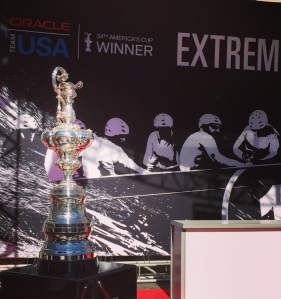I just returned from a successful week spent at Oracle OpenWorld in San Francisco. A nice perk for being in the Bay Area at this time of the year was summer was in full swing! While it was raining buckets back in Boston, I was enjoying the close to 90-degree sunny weather…as I ran between meetings. The conference revolved around Oracle’s push into the cloud, talk of the importance of mobility, smarter access to big data and the demotion of Larry Ellison to CTO…okay the last item was some good humored self deprecation from Mr. Ellison himself while on stage for his keynote Tuesday. He even apologized for missing last year’s main

Not a bad trophy to have at your event…
stage demo since he had been pulled into watching some boat race. Anyways, the area I was focused on was what Oracle was doing in the supply chain and retail/CPG spaces. Oracle did not disappoint with the large number of sessions dedicated to these spaces. So let’s look at 3 things I took away from both the CPG/Retail sessions and the Supply Chain sessions –
The shift in power in the CPG-Retail spaces means a change in how we address it:
- In the retail space Oracle discussed a persona-based approach for their offerings. Clearly traditional retail sub segments are not behaving the way they once did – the customer persona is becoming the driving force not the retail sub vertical. Retailers need to approach personas when it comes to how they best address the consumer need. It is the consumer that will dictate what the rules are. The retailer, with help from their service providers, need to focus on addressing the different personas they are servicing and build the software and solutions around this. This is what we are seeing with Matrix Commerce – as the number of intersections between the consumer and commerce supply chain grows, so does the need for the solution vendors to offer more nimble solutions. Oracle provided an example of how they could work with retailers to equip the retailer with an enhanced view of the customer. They designed a system that allowed the retailer to associate a persona to the way the consumer interacted with the retailer – pulling information from all possible channels. Allowing the retailer to more effectively address the consumers’ needs. Oracle Retail, staying true to what was being discussed on main stage, highlighted the fact the solution had a mobile aspect. Why is this important other than following the buzz? It places the information and analytics in the hands of those working on the retail floor. The mobile delivery of data and analytics means the people at the store level can make better decisions and service the customer in a much more personalized and effective manner. Getting the information closer to the decision makers.
- We are all aware that consumer influence has increased vis-à-vis retailers and CPGs. Oracle highlighted how their solutions are helping CPG companies to be even more efficient and effective in their relationship with the retail channels. Once again it boils down to focusing on better usage of retailer data and the subsequent enhanced collaboration that allows an effective partnership between CPGs and their retailers to meet increasingly savvy consumer requirements. Sony discussed working with Oracle to overhaul their managing of sales and promotions for their PlayStation products and how it was sold through retail channels such as Wal Mart, Gamestop, Target, Amazon and Best Buy. At the core Sony and Oracle worked to harmonize and ensure they had the most reliable data and a system of record from which to build upon. From this they worked on putting together an S&OP process that allowed for Sony to do greater analysis of the insights they were getting from the retailers and how Sony could do a more cost effective and smarter job in marketing and selling the PlayStation. Sony was able to look across all their channels, coupled with other sources of data, to improve their planning cycles for the PlayStation. As they stated – they have a very large competitor, with very deep pockets…so Sony has to do it smarter and more efficiently. Focusing on the fundamental blocking and tackling with the help of Oracle gives Sony a competitive edge in the space.
- Finally, and this was something I heard through many of the sessions for CPG and retail, but there is a real emphasis on how to take advantage of the confluence of mobile – big data – analytics – cloud and focusing on how to drive down more intelligence closer to consumer touch points. This is really about empowering all the players that are close to the consumer, the best data and analytics to make the right decision on the ground. Think about it, you and I as consumers have gained tremendous power in the past decade. Between the transparency the internet has given us to the ability to carry that internet everywhere we go – we as consumers have suddenly put intelligence and insight right into our purses and pockets. The Oracle solutions targeting CPG and Retailers are looking to give the same level of intelligence to the store associates servicing these smarter consumers. The reality is the large systems used to drive CPG and Retail businesses are vital for running the businesses at a macro level. But the trick is how to empower those that are “on the front lines” to have a similar impact on the process.
The overarching theme for CPG and retail was to provide the complete end-to-end solution and platform that will allow for this transformation. Overall they touched many aspects of what we are seeing in Matrix Commerce. The ability to push data and analytics down to the closest touch point of the consumer is vital to reducing the friction that often flares up at those levels.
Supply chain continues to be about better planning…but also easier access to improved execution
- My kingdom for a better plan! Clearly planning remains at the heart of supply chain…really at the heart of business and dare I say life? Yet for some reason it has a bad connotation at times. Yes we all know that all plans carry one similar trait: they are WRONG. But the reality is we really cannot do much without those plans. What was interesting in the discussions of planning was not that Oracle was professing a 99.9% accurate plan, or a faster plan but looking at offering a more responsive planning method. Since being responsive is different that being efficient. Again pulling on the themes of big data – cloud – analytics, they discussed continuing to work on their planning engines that are digging deeper into the data as well as making them more accessible within the planning organization. Panasonic Avionics (they are the division of Panasonic that builds and maintains many of the in flight entertainment units you may leverage when you are flying) for example, has a very challenging supply chain to service. With long component lead times, capacity constraints, high demand volatility and a large array of materials to service (they mentioned that they still need to support some systems that use video tapes!), Panasonic Avionics really needed a system that was able to rapidly identify where the plan would impact the product. In order to properly achieve this, Panasonic and Oracle needed to ensure the planning engine could truly understand the complexity of the BOM and identify where each part of that BOM could be impacted by any fluctuation in the plan. They highlighted the ability to improve the granularity of the information being pulled into the planning process, as well as the ability to run multiple plans to provide the most robust scenarios. The speed at which Panasonic Avionics was able to refresh their plans allowed for rapid insights into potential issues.
- Embracing the cloud – but not just for lower TCO and faster implementations. Like many vendors, dare I say most vendors; there was a strong message around putting solutions up in the cloud. Good. I agree with this thinking. What I also agree with, and what Oracle made clear was this does not mean you have to ignore continuing to offer on-premise solutions. When I sat through a session on Oracle’s transportation and global trade solutions being moved into a cloud offering, what was refreshing was the fact that they made a point to discuss continuing to offer the solution on premise. And that both would maintain the same high level of functionality. The same was true for the discussion around supply chain planning functionality and its migration to the cloud. What was evident was that Oracle seems to grasp the notion that while the cloud is important; it does not prevent them from continuing to offer and support on-premise offerings. I do think that the strategy to give a choice is important and will allow them to target mid-market and individual business units in larger enterprises. Long gone are the days of massive system overhauls and implementations. Supply chains need nimble solutions to keep up with their ever-changing environment.
- Making supply chain solutions even more business friendly. Let’s face it, when it comes to the supply chain function within business, it is still fighting for a place at the big table. Yes we hear of more companies with CSCOs, but I would still wager that number is small compared to CMOs, CFOs, CIOs and yes CEOs. But my last take away from the supply chain discussions is the way Oracle appears to be addressing this issue. For example, they spoke of better tying in what is happening in the supply chain to the marketing side of the house. The solutions stressed the need to drive analytics and better information down the planning stack – get as much rich information where it matters. Decoupling the financial flow from the physical supply chain to better understand how the two interact. Individually these are all nice efforts, but put together they indicate a view of the importance of the holistic supply chain – one that starts on a solid platform where the right data is leveraged. This mirrors what was spoken about on main stage Tuesday, and the overall drive by Oracle to ensure cross channel and cross identity customer experience. How true that is at the core of supply chain – being able to ensure the best view of the customer’s needs and orders.
Oracle’s overall Value Chain solutions are all rowing in the right direction. When you add to the discussion the continuing evolution of Oracle’s Warehouse Management solution that has added Yard management – clients have the ability to access a full suite of execution modules. When it comes to Matrix Commerce, one key need for the commerce supply chain is to ensure the elimination of friction, friction that arises from supply chain blind spots. Not having the full view of your fulfillment can cause supply chain blind spots to sprout.
Oracle continues to maintain its status as a “mega vendor.” Their breadth and depth in terms of solutions and industries make them a serious contender in most situations on the market. We will continue to watch with intent how they address the area.



